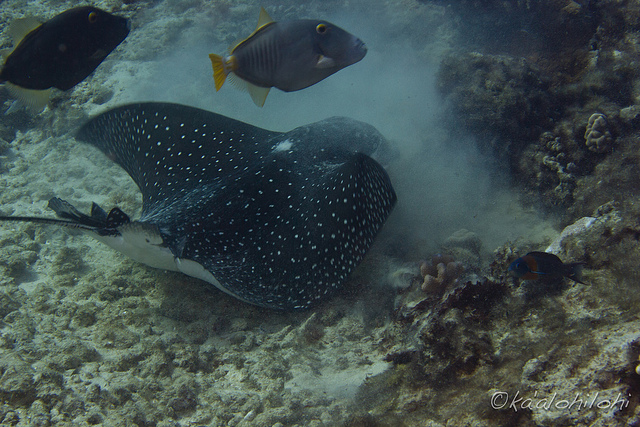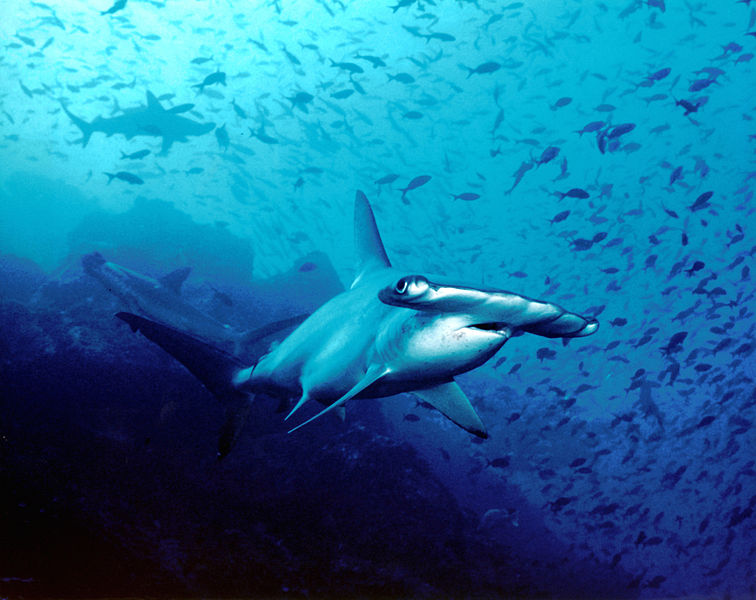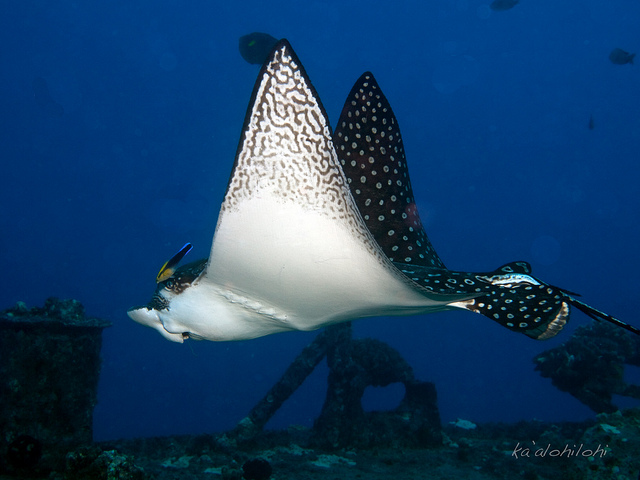Interactions
 Prey
Prey
Spotted eagle rays are an important component of the marine
food web. Aetobatus narinari are carnivorous benthic feeders
and have six primary prey categories: gastropods, bivalves,
crustaceans, echinoderms, polychaete, and other mollusks
(Schluessel et al. 2010). Approximately half of an eagle ray’s
diet is composed of gastropods, such as the endangered queen
conch (Strombus gigas), while the other half is mainly
made up of bivalves, including giant clams and calico clams (Macrocallista
maculata) (Randall 1967, Ajemian et at. 2012).
Occasionally, eagle rays will also feed on small fish, squid,
and cephalopods (Silliman and Gruber 1999).
Predation
 In the marine food web,
A. narinari feed on
organisms on the benthic floor and in turn get preyed upon by larger
organisms. Due to their massive sizes, only the largest predators
pose a threat to this species. Sharks are their main predators.
Specific sharks that target A. narinari include the great
hammerhead (Sphyrna mokkarran), tiger (Galecerdo cuvier),
bull (Carcharhinus
leucas) and Carribbean reef sharks (Carcharhinus perezi)
(Silliman and Gruber 1999). Hammerhead sharks have been observed to
use a pin and pivot technique to capture and consume eagle rays
(Chapman and Gruber 2002). The shark pins the ray to the ocean floor
with its cephalofoil (flat portion of head seen in the photo to the
left) and then pivots its body
until the ray’s head is in its jaws.
In the marine food web,
A. narinari feed on
organisms on the benthic floor and in turn get preyed upon by larger
organisms. Due to their massive sizes, only the largest predators
pose a threat to this species. Sharks are their main predators.
Specific sharks that target A. narinari include the great
hammerhead (Sphyrna mokkarran), tiger (Galecerdo cuvier),
bull (Carcharhinus
leucas) and Carribbean reef sharks (Carcharhinus perezi)
(Silliman and Gruber 1999). Hammerhead sharks have been observed to
use a pin and pivot technique to capture and consume eagle rays
(Chapman and Gruber 2002). The shark pins the ray to the ocean floor
with its cephalofoil (flat portion of head seen in the photo to the
left) and then pivots its body
until the ray’s head is in its jaws.
Parasitic Interactions
A. narinari are
susceptible to a variety of parasites including trematodes, leeches,
and tapeworms. At least four species of Acanthobothrium are
known to have parasitic interactions with A. narinari. In
1995, a previously undescribed species of Acanthobothrium
was discovered in the spiral valve of a spotted eagle ray in the
Gulf of Nicoya. The parasite was named Acanthobothrium
nicoyaense and is a Cestode in the Phylum Platyhelminthes
(Brooks and McCorquodale 1995).

Another parasite that can
infect spotted eagle rays is a trematode called Clemacotyle
australis. In a study conducted by a zoo in the Netherlands,
infestations of C. australis have been shown to induce
stressful behavioral changes in spotted eagle rays (Janse and
Borgsteede 2003). A. narinari in captivity have been
observed leaping out of the water, swimming against strong currents,
and rubbing their bodies along the bottom of the aquarium in
response to the skin trematodes. These actions caused hemorrhages to
develop on their fins and altered their dorsal coloration due to
mucus buildup. If left untreated, the infection, along with the
immense energy expelled by the organism to purge itself, can result
in death. The addition of cleaner wrasse (Labriodes dimidiatus)
to A. narinari display tanks were shown to maintain the
infestation of C. australis at a level where they did not
negatively impact the health of the rays.
Aetobatus narinari & Homo sapiens
Some small fisheries, mainly in the
Southern Gulf of Mexico and Venezuela, specifically target spotted
eagle rays for their meat (Tagliafico et al. 2012). Meat obtained
from A. narinari is readily marketable in Venezuela and is the main
component of a popular dish. In other areas, the rays are often
unintentionally caught as bycatch from industrial fisheries, since
they dwell near the shore where fishing pressures are the greatest,
as mentioned in the habitat section.
A. narinari are classified by
the International Union for Conservation of Nature (IUCN) Red List as
near threatened. Factors that have contributed to their status
include increased fishing pressures for numerous marine species,
overexploitation of these organisms and their primary food sources
(including bivalves and gastropods), and increased competition for
food and space due to a rise in the cownose ray (R. bonasus)
population (Cuevas-Zimbron et al. 2010).
Elasmobrachs,
including Aetobatus narinari, have stingers located on the
dorsal side of their tails. Since stingrays are generally peaceful
creatures, they use their stingers primarily as a form of defense
when provoked (Junior 2013). Their stingers are covered with a layer
of specialized epidermal cells that produce and secrete venom
(Pedroso 2007). Humans often accidentally come into contact
with these organisms while walking through waters near their habitat
or while attempting to release them from hooks and nets. Humans
inoculated with their venom can experience serious side effects,
including acute inflammation and pain, skin necrosis, and in some
extreme cases, death (Pedroso 2007).
Spotted eagle
rays have also proven to be useful in research. Researchers can use
tissues found in their stinger to extract and analyze their DNA
(Janse et al. 2013). As the number of fishes worldwide starts to
deteriorate, breeding programs for animals in captivity become
important. DNA research and analysis can help maintain genetic
variability in captivity, and ensure successful future generations.
Lost stingers have the ability to easily grow back, so this method
of DNA acquisition is non-invasive and causes no lasting damage to
the organism. This DNA extraction method is also applicable to other
species of elasmobranchs. If you're interested in learning more
about the research being conducted on spotted eagle rays, check out this
video.
Continue on to learn about some really cool Facts, or return to the Home page.
